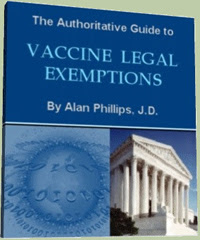Christina England
Activist Post
Changes in the new Diagnostic and Statistical Manual of Mental Disorders (DSM 5) for the criteria of Autism Spectrum Disorder (ASD) could mean a high percentage of children currently diagnosed with autism, as per the DSM 4, could lose their diagnosis. Professionals are worried that the change in criteria will put many autistic children at considerable risk.
Age of Autism reported that Dr. Allan Frances, the psychiatrist who headed the development of the current DSM 4, is concerned that the new changes could cause children currently diagnosed with the condition to lose their health insurance, school placement, Medicaid and other services when the Diagnostic and Statistical Manual, Fifth Edition (DSM5) is published by the American Psychiatric Association in May. [1]
WHAT THIS MEANS FOR YOUR CHILD
Due to a rise in the numbers of children currently diagnosed with autism, the cost to the government is considerable. According to Autism Speaks, the world’s leading autism science and advocacy organization, research has shown that the annual cost of autism had tripled to a whopping $126 billion in the USA and £34 billion in the UK last year.
The costs of providing care for each person with autism affected by intellectual disability through his or her lifespan are $2.3 million in the U.S. and £1.5 million ($2.4 million) in the U.K. The lifetime costs of caring for individuals who are not impacted by intellectual disability are $1.4 million in the U.S. and £917,000 in the U.K. (equivalent to $1.46 million). [2]
Bob Wright, the co-founder of Autism Speaks, announced in a press release last year that autism is a global public health crisis. He stated that the costs are staggering and will continue to rise as its prevalence continues to increase. He said:
We know that early diagnosis and treatment are critical, so it is imperative that the U.S. and governments around the world step up their commitment to helping people living with autism today. The investment we make now is essential to reducing the long-term costs of autism. [2]
Changing the criteria for diagnosis in the new DSM 5 is one way to cut costs, but it will severely affect the lives of thousands of families. Many children with autism will not only lose their diagnosis but their educational provisions, healthcare and relevant medical services, while their symptoms and needs will not change.
THE BIBLE YOUR CHILD’S DOCTOR MIGHT USE
 The Diagnostic and Statistical Manual of Mental Disorders, published by the American Psychiatric Association, “is used by clinicians and psychiatrists to diagnose psychiatric illnesses … and covers all categories of mental health disorders for both adults and children. The manual is non-theoretical and focused mostly on describing symptoms as well as statistics concerning which gender is most affected by the illness, the typical age of onset, the effects of treatment, and common treatment approaches.”
The Diagnostic and Statistical Manual of Mental Disorders, published by the American Psychiatric Association, “is used by clinicians and psychiatrists to diagnose psychiatric illnesses … and covers all categories of mental health disorders for both adults and children. The manual is non-theoretical and focused mostly on describing symptoms as well as statistics concerning which gender is most affected by the illness, the typical age of onset, the effects of treatment, and common treatment approaches.”
Currently, the medical profession relies heavily upon the criteria established in the DSM for diagnosing many neurological, psychological and medical conditions, including autism and ADHD. The current DSM 4 has five categories for diagnostic purposes. These are:
Axis I: Clinical Syndromes
This axis describes clinical symptoms that cause significant impairment. Disorders are grouped into different categories, including adjustment disorders, anxiety disorders, and pervasive developmental disorders.
Axis II: Personality and Mental Retardation
This axis describes long-term problems that are overlooked in the presence of Axis I disorders. Personality disorders cause significant problems in how a patient relates to the world and include antisocial personality disorder and histrionic personality disorder. Mental retardation is characterized by intellectual impairment and deficits in other areas such as self-care and interpersonal skills.
Axis III: Medical Conditions
These include physical and medical conditions that may influence or worsen Axis 1 and Axis II disorders. Some examples may include HIV/AIDS and brain injuries.
Axis IV: Psychosocial and Environmental Problems
Any social or environmental problems that may impact Axis I or Axis II disorders are accounted for in this assessment. These may include such things as unemployment, relocation, divorce, or the death of a loved one.
Axis V: Global Assessment of Functioning
This axis allows the clinician to rate the client’s overall level of functioning. Based on this assessment, clinicians can better understand how the other four axes are interacting and the effect on the individual’s life. [3]
EVEN TEMPER TANTRUMS MIGHT BE CALLED A DISORDER
Many professionals feel that the medical establishment relies too heavily on the DSM’s criteria for diagnosing a patient. Dr. Allan Frances believes that the DSM should not be thought of as the diagnostic bible. He has stated that the new DSM 5 is heavily flawed and that many of the changes are unsafe and scientifically unsound. He believes that this could eventually lead to unreliable diagnoses and said:
DSM 5 got off to a bad start and was never able to establish sure footing. Its leaders initially articulated a premature and unrealizable goal – to produce a paradigm shift in psychiatry. Excessive ambition combined with disorganized execution led inevitably to many ill conceived and risky proposals. [4]
Dr. Frances said that more than fifty mental health professional associations have heavily criticized the changes, asking for an outside review to be carried out. This request is to provide an independent judgement of the DSM 5’s supporting evidence and to evaluate the balance between its risks and benefits. He says that other professionals and organizations have expressed widespread astonishment over recent decisions, which are said to lack scientific support and defy common sense.
In his article, he listed the ten worst changes. These include temper tantrums, which could soon be diagnosed as Disruptive Mood Dysregulation Disorder and the new changes for autism, which Dr. Frances says will result in lowered rates of diagnosis.
The new criteria for autism estimated by the DSM 5 work group is set to lower the rates of autism diagnosis by ten percent. However, many outside research groups estimate that this decreased rate of diagnosis could be as high as fifty percent. Dr. Frances believes that the swing is heavily weighted in favor of psychiatry and therefore will benefit the pharmaceutical industry.
Many people believe that autism is over diagnosed and will welcome the new changes. Others believe that the rates have risen due to a better understanding of the condition. An article written by Reuters has outlined the questions people are asking regarding the spike in the prevalence of autism and related disorders. Some people question if the increase is real or if the rise was due to parents, teachers, and even health care providers who are better able to identify symptoms of autism in children who would not have received the diagnosis a generation ago.
The Reuters article suggested that some change in the environment might be responsible and said, “In recent years, suspicion has focused on everything from mercury, a known neurotoxin in air and food, to the increasing age of new mothers and fathers.” [5]
Psychologist and specialist in autism Lisa Blakemore-Brown believes that vaccines are responsible for the rise and outlined an example of a case in the British Medical Journal of a vaccine-damaged child that she had worked with:
If a group of people collapse after eating, say, Lemon Sole, in a particular restaurant, it would be ludicrous for those responsible to wave a hand over the problem saying that millions of people eat Lemon Sole every day and there are no problems. Health and Safety officials will get straight to the point of the issue and look at the fish in the restaurant, look at the individuals, test findings in the lab.
As hundreds of parents have found their children have reacted adversely to vaccines, some cases have led to the ‘new variant autism,’ including loss of communication skills, motor impairments and bowel problems. Is it not these cases the government should be looking at for answers?
The incidence of this particular tapestry of autism is indisputable. This is not related to increased recognition of autism. This type of autism is unusual and baffling to education and health professionals. In one of my cases, of very obvious and indisputable reaction to pertussis vaccine, the child in question has been found to have Kawasaki disease, her own immune system attacking itself. She presents as having Asperger’s Syndrome. There is no autism in the family, but the baby had allergies prior to the vaccine. It is scientific examination of cases like this which will enable us to ultimately put measures in place to reassure the public.
Blanket refusal to look at the real issues and prevention of individuals exercising choice seems like a dangerous policy, especially just before an election. [6]
So, why have these changes taken place?
It is very convenient for changes to be made in the criteria of autism diagnosis, especially at a time when the figures are reported by the CDC to be at an all time high. The CDC reports that, according to estimates from CDC’s Autism and Developmental Disabilities Monitoring (ADDM) Network, approximately 1 in 88 children have been identified to be suffering from an Autism Spectrum Disorder (ASD). [7]
These changes become even more interesting, especially when you consider that at the same time as the criteria for autism embarks on an overhaul, a new report referencing a recent study published in the Polish journal Acta Neurobiologiae Experimentalis identifies the intensifying link between mercury toxicity and ASD.
BUT I THOUGHT VACCINES NO LONGER CONTAIN MERCURY?
 Natural News shared information based on a report entitled “Evidence of Parallels Between Mercury Intoxication and the Brain Pathology in Autism,” identifying a shocking 20 parallels between mercury poisoning and autism. According to Natural News, the study from the Institute of Chronic Illnesses in Maryland has identified nearly two dozen metabolic and systemic changes that occur inside the body as a result of mercury intoxication, including inflammation of the brain, intracellular degeneration, mitochondrial dysfunction, decreased blood flow to the brain, and pathological changes of blood vessels. [8]
Natural News shared information based on a report entitled “Evidence of Parallels Between Mercury Intoxication and the Brain Pathology in Autism,” identifying a shocking 20 parallels between mercury poisoning and autism. According to Natural News, the study from the Institute of Chronic Illnesses in Maryland has identified nearly two dozen metabolic and systemic changes that occur inside the body as a result of mercury intoxication, including inflammation of the brain, intracellular degeneration, mitochondrial dysfunction, decreased blood flow to the brain, and pathological changes of blood vessels. [8]
These are the very same changes that commonly occur in children with ASD. Many of these children have been vaccinated with vaccinations containing mercury in the form of thimerosal.
Thimerosal is a preservative that is 49.6% ethyl mercury. According to Blakemore-Brown, it is a highly toxic poison that is both genotoxic and neurotoxic. It collects in the brain and organs such as the kidneys and interferes with our DNA, which can affect our brain and immune system. She attributes the huge increase in the incidence in autism to thimerosal in vaccinations. [9]
Over the years, there has been a fierce debate as to whether childhood vaccinations still contain the preservative thimerosal because the preservative was believed to have been completely removed. Sadly, this never happened and many vaccines do still contain mercury, albeit at a reduced level. [10] The FDA was forced to admit in court recently that the preservative is still routinely used in childhood vaccines. Natural News reported:
The Food and Drug Administration (FDA) has revealed that, contrary to this widely-held belief, thimerosal is actually still present in many batch vaccines, including in the annual influenza vaccine that is now administered to children as young as six months old. [11]
CONCLUSION
There appears to be yet another cover up going on. It is very convenient for the criteria for autism to suddenly be changed, especially when this change has the potential to lower the level of diagnosed cases of autism. It is even more convenient for this to happen when the FDA has been forced to admit that childhood vaccines still contain thimerosal, just when a new study identifies a shocking twenty parallels between mercury poisoning and autism.
By shifting the goalposts, the governments can deny that the mercury in vaccines is causing a rise in autism and lower the rates being diagnosed all at the same time. Very clever move, isn’t it? Not only that, but changes to the new DSM 5 could lead to many of our autistic children being diagnosed as having a mental illness and be administered psychiatric drugs as a result. While this is a win-win situation for the government and the pharmaceutical industry, our children will be the sacrifice.
References:
1. http://www.ageofautism.com/2013/02/autism-action-network…
2. http://www.autismspeaks.org/about-us/press-releases/annual-cost-of-autism-triples
3. http://psychology.about.com/od/psychotherapy/f/faq_dsm.htm
4. http://www.psychologytoday.com/blog/dsm5-in-distress/201212/dsm-5-is-guide-not-bible…
5. http://uk.reuters.com/article/2012/03/29/us-autism-idUSBRE82S0P320120329
6. http://www.bmj.com/content/322/7279/130.3?tab=responses
7. http://www.cdc.gov/ncbddd/autism/data.html
8. http://www.naturalnews.com/039328_autism_mercury_toxicity_brain…
9. http://thimerosalthoughts-bb.blogspot.co.uk/
10. http://www.cdc.gov/vaccinesafety/concerns/thimerosal/thimerosal_timeline.html
11. http://www.naturalnews.com/035432_vaccines_mercury_court…
This article originally appeared at VacTruth.com
http://vactruth.com/2013/03/09/changes-to-autism-diagnosis/
RELATED ACTIVIST POST ARTICLE:
Autistic Children Significantly More Social When Pets Are Around: Study
Christina was born and educated in London, U.K. She left school to work in a children’s library, specializing in story telling and book buying. In 1978 Christina changed her career path to dedicate her time to caring for the elderly and was awarded the title of Care Giver of the Year for her work with the elderly in 1980. In1990 she adopted the first of two disabled boys, both with challenging behavior, complex disabilities and medical needs. In 1999 she was accused of Munchausen by Proxy after many failed attempts to get the boys’ complex needs met. Finally, she was cleared of all accusations after the independent psychologist Lisa Blakemore-Brown gave both boys the diagnosis of Autism Spectrum Disorder and ADHD as part of what she described to be a complex tapestry of disorders. During the assessments Ms Blakemore-Brown discovered through the foster care diaries that the eldest boy had reacted adversely to the MMR vaccine. After taking an A Level in Psychology and a BTEC in Learning Disabilities Ms. England spent many years researching vaccines and adverse reactions. She went on to gain a Higher National Diploma in journalism and media and currently writes for the American Chronicle, the Weekly Blitz, VacTruth and Namaste Publishing UK on immunization safety and efficacy whilst continuing to study for a BA Honors degree in English Literature and Humanities. England’s main areas of expertise are researching false allegations of child abuse and adverse reactions to vaccines. Her work is read internationally and has been translated into many languages. Ms England has been a guest on many radio shows and has spoken at seminars worldwide. She is the co author to the book ‘Shaken Baby Syndrome or Vaccine Induced Encephalitis – Are Parents Being Falsely Accused?’ with Dr Harold Buttram.
linkwithin_text=’Related Articles:’




Be the first to comment on "Will New Changes to Autism Diagnosis Leave Your Child in the Cold While Filling Big Pharma’s Pockets?"